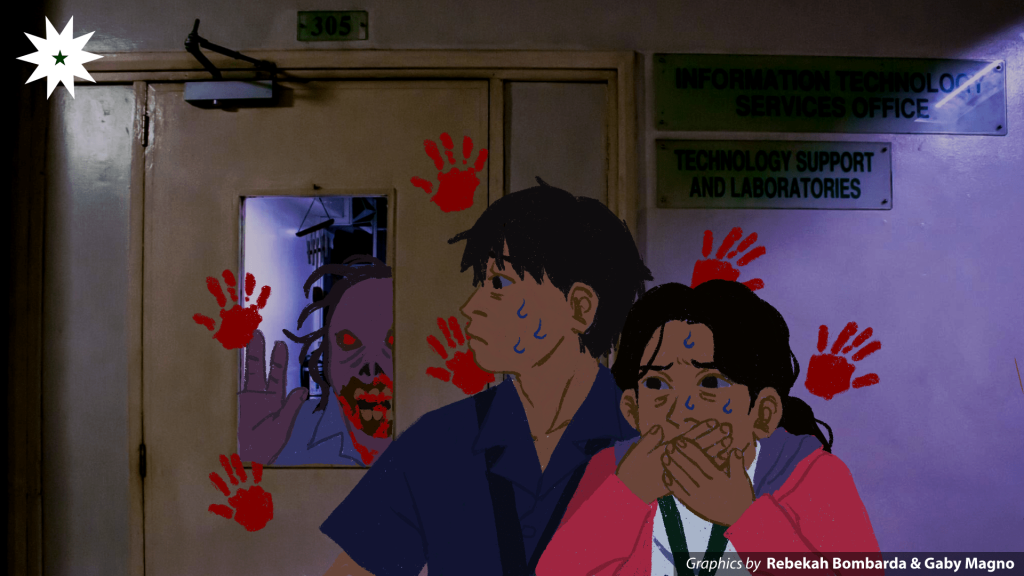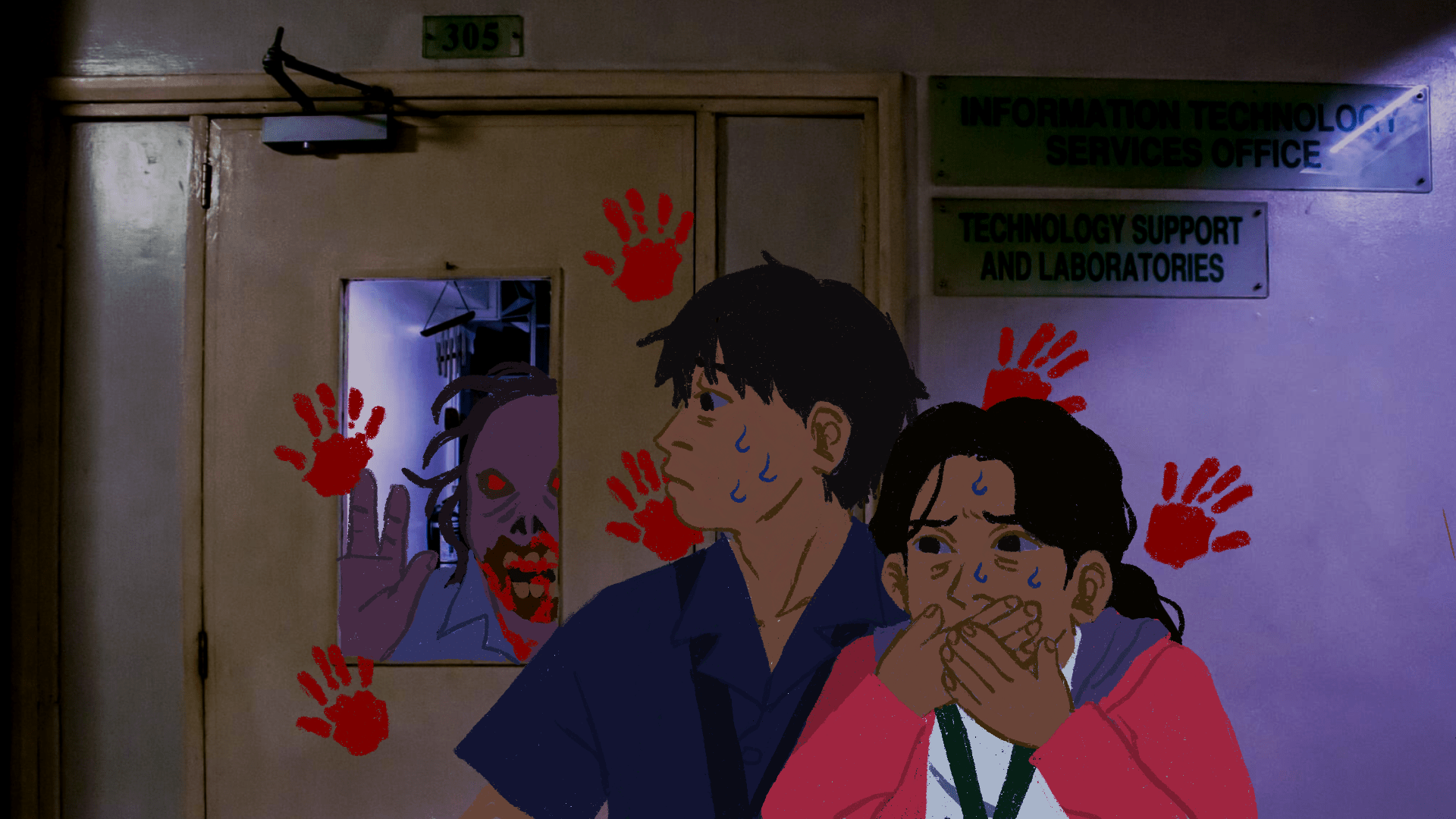One can agree that a zombie apocalypse is one of the most sensationalized themes in all sorts of media. Contracting the zombie-causing disease could range from catching a virus to eating cadavers, with different versions of a bloody outbreak portrayed. However, these stories all eventually just focus on a certain plot: following the typical survivors that somehow overcome extraordinary circumstances.
After All of Us Are Dead showed how alarming a possible zombie outbreak is in a school setting, fears surrounding its likelihood to happen in De La Salle have been raised by some students. Following the gradual reopening of the campuses, one might wonder just what the situation would be should an outbreak happen within the confines of the University.

I will (?) survive
To survive, seeking refuge somewhere for safety is crucial. However, in determining which on-campus locations might be best, a number of factors should be considered, such as available resources, accessibility, and defensibility. With these in mind, Executive Director for Campus Services Karen Hebron recommends that students look into Perico’s and the machine lab in Velasco “where [engineering students] kiskis bakal for their dice.”
She reasons that Perico’s is a strategic location, “There’s food, there’s relatively okay ventilation, and it’s beside a parking lot and the South Gate, making it easy for escapes just in case.” Furthermore, Hebron points out that the steel doors surrounding the cafeteria could provide defense from zombies.
Dana Pathay (MKT, ‘13) affirms this, stating, “Brraa skrrt skrrt rawrmeow graah boom kreek chuchuwaah.”
(She’s right, we will have a hard time parang make sira those doors unless we come as a mob to eat your brains, siz.)
The machine lab, on the other hand, could provide aspiring zombie apocalypse survivors with options for weapons. “We know it’s not right to promote violence anywhere, that’s why you didn’t hear this from me,” advises someone from the University who is very knowledgeable about the campus. “But how else can we fend for ourselves against zombies if not with weapons?” they assert.
Apart from the students’ unfinished projects and untouched raw materials, the mystery interviewee says the said lab is a gold mine for zombie-fighting weapons, “Fr fr ngl. Istg.”
(I promise that I am telling the truth and nothing but the truth. Amen.)
On this regard, they-who-shall-not-be-namedropped adds that the chemical engineering lab at the other end of the hallway—the Unit Operations Laboratory—could provide the chemicals to make molotovs and bombs. However, they caution, “Just be careful not to actually destroy school property. You might be fine, even if it’s a zombie apocalypse.”
In terms of good hideouts within the campus, Hebron also mentions the top floor of the Br. Andrew Gonzalez FSC Hall, which could connect to the rooftop of the Henry Sy Sr. Hall via zipline; the mezzanine floor of St. La Salle Hall where the Institute of Biomedical Engineering and Health Technologies is located; not the Amphitheater; and the “haunted” William Shaw Little Theater, among others.
Bro?
However, students would not only need physical resources to survive. Apart from guts, knowledge about St. John Baptist de La Salle and the University, in general, would also determine one’s fate.
Unknown to many, the University has actually prepared a zombie apocalypse measure: the Don’t Die Today protocol. It would only be activated once the microphones hidden beneath the ceiling of each hallway would hear the “Ssdvksdvjbsdjbraaawrbksdvbjvkdl,” which would then trigger the “red blaring lights that go wee-woo-wee-woo,” reveals DLSU President Br. Bernard Oca FSC.
(Dude, pare, bro, what’s up na, mga chong! Let’s get it, siz!)
He discloses that this idea for such a protocol was actually from Teletubbies—where speakers would pop up to give reminders to Tinky-Winky, Dipsy, Laa Laa, and Po. “Beautiful Dreamer would play right after the red lights go off, the students will be asked when the birthdate of St. La Salle is via the speakers. If they answer it right, they get transported to a zone less likely to have more than 100 zombies,” Oca states. If students answer wrong, however, they will have to enroll in a “possibly zombie-free” orientation course on the life of the University’s founder.
Oca clarifies that no microphones or mobile application will need to gather the students’ answers as St. La Salle himself would be able to hear them.
Those who manage to answer the filtering question, meanwhile, may get to live relatively longer. Once transported in what is secretly a DLSU office in Gokongwei Hall, students who have so far lived through the Don’t Die Today protocol will be tested—silently.
After DLSU lead researcher Dr. Zion Triste identified that would-be zombies are sensitive to hearing, another key to survival would be learning how not to say words such as “bro”, “sizter”, “pare”, and “momme”, among others. “The zombies we are expecting would be, in a way, ‘localized’ and these words would trigger them to attack and eat you—but not in that way,” he states.
Thus, those spared from the first wave of zombies would have to be extremely quiet and conscious of what they say. One whisper of the trigger word, after all, could cost them and others’ lives.
“Rslkbjdsaarwdsknereeuuuldodjdcndkl dlskvjblkdsvbkjssszziuzhaaa,” interjects Joaquin Dedd (MGT, ‘18), a zombie who was interviewed online.
(I just want to know what you meant by wanting space? Do you want to go out there or do you want to take a break?)
However, as with the previous wave, not all would theoretically survive. “I don’t believe everyone could resist saying, ‘bro,’ for an indefinite amount of time. I guess they’ll die,” Triste postulates.
Blessed be the undead
Designed not to get in the way of natural selection, Oca clarifies that like health insurance, there are certain limits to what Don’t Die Today covers. The University president divulges that currently, the protocol only caters to undergraduates, faculty, and staff of the Manila Campus, “You can’t always get what you want.”
As covered by the protocol, in the event that a student turns into a zombie, they get to choose whether to be a free-range zombie or one that will be housed in La Salle. In-house zombies would be the residents of the Science and Technology Research Center, the country’s leading zombie research facility—ranking first—according to the Thymes Higher Education Rankings, under the Zombie and Apocalyptic Studies category. “There, they will be used as both stand-ins for ornaments and as specimens for further research,” clarifies Triste.
“I think this is the best way forward—we take care of them by feeding them raw meat, and they provide us with what they can physically,” Oca remarks. “Basically, we will own 51 percent of their body.”
Once the body is almost fully scrapped from the bones, the brother president says that they would be bathed in holy water as a last measure to prevent the spirit of the undead from haunting the campus. “We don’t want that, diba?” he ends.
While the zombie protocol is far from perfect or even encompassing, the initiative is a welcome start to acknowledging the imminent bloody apocalypse. As they say, better prepared than eaten alive by an undead alumnus from the early 1900s.



